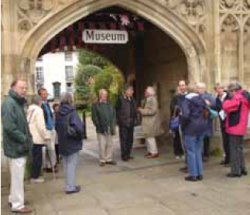Trust Visit to Malvern - TrustNews Dec 12

On 25th September 18 members of the Trust visited Great Malvern at the invitation of the Malvern Civic Society. We were welcomed at the Great Malvern Hotel by their Chairman and Vice President, and while we enjoyed coffee and scones they gave us a brief history of the town.
In spite of its name Great Malvern was a small village until the 1840s when two doctors, Dr Wilson and Dr Gully, decided to establish a hydrotherapy centre making use of the plentiful clear water in the many springs at the edge of the granite hills above the town. Although the water contains no minerals the treatments involving bathing and being splashed with the cold water was found to be beneficial to the visitors who poured into the newly created town.
Our two guides took us on a walk round the town. Its beautiful site below the hills and with stunning view over the Vale of Evesham made us understand why people visited here. One guide told us he was 88, and as he marched briskly off up the steep hills and we puffed along behind, we were given a good advertisement for the health-giving properties of Malvern.
There are many lovely Victorian buildings dating from the middle of the 19th century, and Great Malvern has had its conservation area since 1959. Many well-known people stayed here and the Civic Society is marking the houses associated with them with blue plaques. We heard about G.B.Shaw, C.S.Lewis, Jenny Lind, Haile Selassie, and of course Sir Edward Elgar.
The railway arrived from Worcester in 1859. Most of the land in Great Malvern had belonged to Lady Foley, and she would only allow the railway line to be built in a cutting in the lower part of the town, and only first class passengers were allowed to use the station. The lower ranks had to get on and off further away!
After a delicious buffet lunch we visited Malvern Priory, a Benedictine Abbey dating back to 1085. Dedicated to St. Mary and St. Michael it is larger than the neighbouring Abbey in Little Malvern. Hence we were in ‘Great’ Malvern. It is a surprise to go into a perpendicular church and find a magnificent arcade of Romanesque columns. The 15th century windows are the largest in any parish church in England. At the Reformation the church was bought by the town for £20 - a good bargain we thought - though the population of 120 families took over two years to raise the money. We loved the church with its fine misericords, and a wonderful display of encaustic tiles dated 1453 which were displayed on the wall behind the altar. Some new windows by Thomas Denny were much admired by some of us.
After the Priory we went to the museum which is housed in the Priory gateway, with carefully laid-out rooms devoted to different periods of history. We none of us fancied trying the water treatment!
The following morning we were able to explore just how much this area has to offer visitors. Some energetically walked on the hills, some visited Elgar’s house, many went to the Morgan factory, or to Tewkesbury or to see the Capability Brown garden being restored at Croome Park.
For many of us a high point of the visit came in the afternoon when we went to see the garden at Perrycroft, where Mr and Mrs Archer, the owners, also showed us round their wonderful house. It was designed in 1893 by CFA Voysey for the then member of parliament, Mr. J. Wilson. The Archers have lived there for 10 years, and they have spent the time restoring the house to its original state and filling it with arts and crafts furniture and artefacts. Their pride and delight in the house was most infectious and we came away filled with admiration for Voysey’s imagination and attention to detail. It was bought from the Boys‘ Brigade, who had completely neglected the garden, and that too has been beautifully recreated.
This was a most stimulating and entertaining visit. We were all grateful to Iain Patton for the work he had done in arranging it, and the Malvern Civic Society for their welcome.
